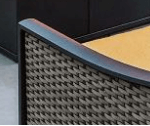“Faux Wicker” Explained
“Faux Wicker” is a misnomer. “Wicker” is a specific pattern of weaving that has been around for many years. Most often manufacturers build wicker items by weaving strands of willow, rattan, or other natural materials. While the wicker pattern creates a strong structure, over time the strands of natural material tend to fray and splinter. Also, many times wicker furniture is painted and as it weathers the furniture loses its desired aesthetic.
“Synthetic wicker” or “Faux wicker” means a non-natural material (polyethylene) woven into a wicker pattern to create a piece of furniture. Some of our vendors like Splash Pools and Tropitone (outdoor furniture) use high-quality faux wicker for its many advantages.
Faux wicker is stronger, and twice as UV resistant. The color is embodied when the resin is still liquid and anti-UV ray solution is incorporated, meaning that due to sun exposure it will not fray or splinter over time.
There are two ways synthetic wicker can be woven. The first is when skilled craftsmen take strands of polyethylene and weave them tightly by hand as one would with natural strands of material.
The other method is not woven at all. Instead, the liquid polyethylene is poured into a mold that emulates the pattern of wicker. Thus, the finished product is not woven, but one solid piece of polyethylene that looks like it has a wicker pattern. Both methods can be beautiful, but the hand-weaving is still seen as more luxurious.


